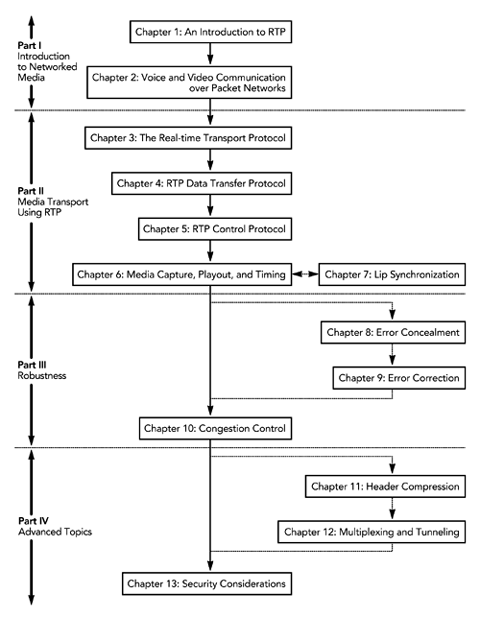| The book is logically divided into four parts : Part I, Introduction to Networked Multimedia, introduces the problem space, provides background, and outlines the properties of the Internet that affect audio/video transport: -
Chapter 1, An Introduction to RTP, gives a brief introduction to the Real-time Transport Protocol, outlines the relationship between RTP and other standards, and describes the scope of the book. -
Chapter 2, Voice and Video Communication over Packet Networks, describes the unique environment provided by IP networks, and how this environment affects packet audio/video applications. The next five chapters, which constitute Part II, Media Transport Using RTP, discuss the basics of the Real-time Transport Protocol. Road Map for This Book  You will need this information to design and build a tool for voice-over-IP, streaming music or video, and so on. -
Chapter 3, The Real-time Transport Protocol, introduces RTP and related standards, describes how they fit together, and outlines the design philosophy underpinning the protocol. -
Chapter 4, RTP Data Transfer Protocol, gives a detailed description of the transport protocol used to convey audiovisual data over IP networks. -
Chapter 5, RTP Control Protocol, describes the control protocol, which provides reception quality feedback, membership control, and synchronization. -
Chapter 6, Media Capture, Playout, and Timing, explains how a receiver can reconstruct the audiovisual data and play it out to the user with correct timing. -
Chapter 7, Lip Synchronization, addresses a related problem: how to synchronize media streams ”for example, to get lip synchronization. Part III, Robustness, discusses how to make your application reliable in the face of network problems, and how to compensate for loss and congestion in the network. You can build a system without using these techniques, but the audio will sound a lot better, and the pictures will be smoother and less susceptible to corruption, if you apply them. -
Chapter 8, Error Concealment, addresses the issue of concealing errors caused by incomplete reception, describing several techniques a receiver can use to hide network problems. -
Chapter 9, Error Correction, describes techniques that can be used to repair damaged media streams, where the sender and receiver cooperate in repairing the media stream. -
Chapter 10, Congestion Control, discusses the way the Internet responds to congestion, and how this affects the design of audio/video applications. Finally, Part IV, Advanced Topics, describes various techniques that have more specialized use. Many implementations do not use these features, but they can significantly improve performance in some cases: -
Chapter 11, Header Compression, outlines a technique that can significantly increase the efficiency of RTP on low-speed network links, such as dial-up modems or cellular radio links. -
Chapter 12, Multiplexing and Tunneling, describes how several media streams can be combined into one. The intent is to improve efficiency when many similar streams are to be transported between gateway devices. -
Chapter 13, Security Considerations, describes how encryption and authentication technology can be used to protect RTP sessions; it also describes common security and privacy issues.  |
